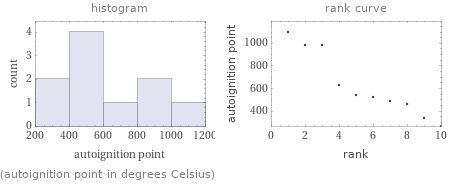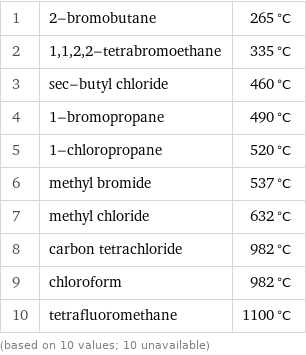Input interpretation

alkyl halides | autoignition point
Summary

median | 528 °C highest | 1100 °C (tetrafluoromethane) lowest | 265 °C (2-bromobutane) distribution | | (based on 10 values; 10 unavailable)
Entities with missing values

fluoromethane | ethyl fluoride | difluoroethane | fluoroform | 1, 1, 2, 2-tetrafluoroethane | 1-fluorohexane | sym-tetrachloroethane | 1, 1-dibromoethane | bromoform | carbon tetrabromide (total: 10)
Distribution plots

(autoignition point in degrees Celsius)
Autoignition point rankings

1 | 2-bromobutane | 265 °C 2 | 1, 1, 2, 2-tetrabromoethane | 335 °C 3 | sec-butyl chloride | 460 °C 4 | 1-bromopropane | 490 °C 5 | 1-chloropropane | 520 °C 6 | methyl bromide | 537 °C 7 | methyl chloride | 632 °C 8 | carbon tetrachloride | 982 °C 9 | chloroform | 982 °C 10 | tetrafluoromethane | 1100 °C (based on 10 values; 10 unavailable)
Unit conversions for median autoignition point 528 °C

802 K (kelvins)

983 °F (degrees Fahrenheit)

1443 °R (degrees Rankine)

423 °Ré (degrees Réaumur)

285 °Rø (degrees Rømer)
Comparison for median autoignition point 528 °C

(170 to 800) °C below typical temperature of magma (700 to 1300 °C)

≈ typical temperature of an electric oven during self-cleaning (900 °F)

201 °C above melting point of lead (327.46 °C)
Corresponding quantities

Thermodynamic energy E from E = kT: | 69 meV (millielectronvolts)

Blackbody energy flux Φ from Φ = σT^4: | 23418 W/m^2 (watts per square meter)

Approximate luminous exitance from a planar blackbody radiator perpendicular to its surface: | 0.027 lx (lux)